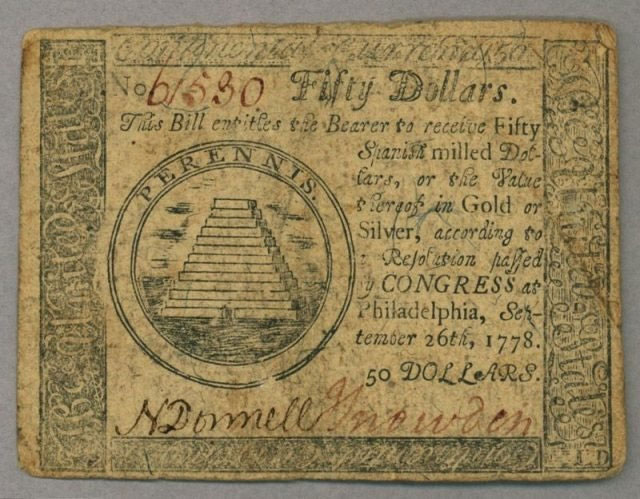The story behind the highest denomination USD bill: 100,000 USD

The $100,000 bill, the highest denomination bill in the United States.
War, people killing each other, families divided, friends separated also for money. Sometimes people with money think that money makes them a better person than someone who has worked hard all his life and still has no money. Greed for money has become a translation.
According to The Vintage News, America's first banknote was a $2 bill issued in 1776. In 1861, during the Civil War, the US Treasury Department issued a blue Demand Notes bill nicknamed "greenbacks" ". In 1862, American banknotes began to be issued with serial numbers and the seal of the Treasury Department was born.
The dollar bill had many decorative motifs, so the government started to organize the design of the money. During the Civil War, the Confederate States of America issued its own coins, which quickly became worthless at the end of the war. The Confederate States of America only existed from 1861 to 1865. The coins they issued were called Confederate States dollars.

Confederate States dollar $50 bill from 1778.
However, some coins still exist and as the years go by, they become increasingly valuable, especially if the coin features a Confederate States of America or slave image. An 1864 Confederate note with the image of General Stonewall Jackson in $500 today can cost anywhere from $200 to thousands of dollars, depending on the condition of the note.

2 dollar bill, issued in November 1862.
According to the American Currency Education Program, all U.S. currency issued since 1861 is still exchangeable for money of value, however one can sell it back to coin collectors and earn more bargain.
After the war, the Bureau of Engraving and Printing was established with the main task of focusing on issuing money. In 1889, Congress was officially named under the portraits on all bills. The cost of issuing banknotes continued to increase, so by 1929, notes were issued with an area of about 30% smaller and standardized designs to easily detect counterfeits.
At that time, large denomination notes were issued of $10,000 with a portrait of Salmon P. Chase, Secretary of the Treasury during Abraham Lincoln's presidency, a $500 bill featuring President Grover Cleveland, The $5,000 bill features President James Madison, and the highest-denomination bill issued in American monetary history is the 1934 $100,000 gold certificate with President Woodrow Wilson on the front.
Most high-denomination notes are used only in transactions between banks and governments. Very few high-denomination notes were issued, and in 1969 the Treasury Department ceased it altogether. Although the government still accepts these bills, if sold to collectors, a $100,000 bill can cost as much as $140,000. If a large denomination note remains in circulation, the Treasury will forfeit it and destroy it.

Front and back of the $100,000 bill.
In 1955, the US government mandated that all banknotes issued since 1957, starting with the 1 dollar bill, had to print the words "In God We Trust". And by 1963, all USD bills had to have that inscription. From 1914 to 1933, people could take paper money and exchange it for gold or silver of equal value. After 1933, people could only exchange money for silver.
Prior to 1965, all coins were made of silver, but President Lyndon Johnson called for coins to be produced with less than 40% silver, creating today's "sandwich" coins, added add another base metal. By 1968, money was no longer traded in exchange for any precious metals. In 1996, the US currency was redesigned with a larger portrait and more security features.
Coins come and go depending on their popularity. The silver dollar with President Dwight D. Eisenhower was used in the 1970s, and the half-dollar bill featured President John. So did F. Kennedy.
Both coins were large and heavy and were not popular with the general public. The Susan B. Anthony $1 bill, issued in 1979, was not well received because it was often confused with the quarter note. The Sacagawea gold dollar, although still in circulation, is not very popular and some have commented that it looks like play money.
America's currency will continue to change as counterfeiters can copy more sophisticated and similar. But the conclusion is, whatever your preference, banknotes or coins, it will probably always be needed in today's world.
- The truth after the hospital bill is paid with a glass of milk
- Why is Bill Gates called a
- 9 interesting little facts about US $ 100 sheets
- Little known story about the person with the highest IQ in the world recognized by Guinness
- 10 immortal sayings of billionaire Bill Gates
- How did Bill Gates start - The founder of Microsoft
- 10 interesting facts about Bill Gates
- 13 facts about Bill Gates
- Bill Gates: Efforts to develop HIV vaccines
- The project funded by Bill Gates predicts that the next pandemic will kill 33 million people in 25 days
- Bill Gates' new style of toilet: No water needed, no waste left to smell, can separate water from feces
- 10 Gates of life's maxim
 Biography of hero Vu A Dinh
Biography of hero Vu A Dinh History of hematology
History of hematology Who is Mr. Tam Da 'Phuc-Loc-Tho' and what does it mean?
Who is Mr. Tam Da 'Phuc-Loc-Tho' and what does it mean? Unbelievable facts about the history of the oil and gas industry: Gasoline used to be cheaper than water, so abundant that it had to be dumped into the river...
Unbelievable facts about the history of the oil and gas industry: Gasoline used to be cheaper than water, so abundant that it had to be dumped into the river...